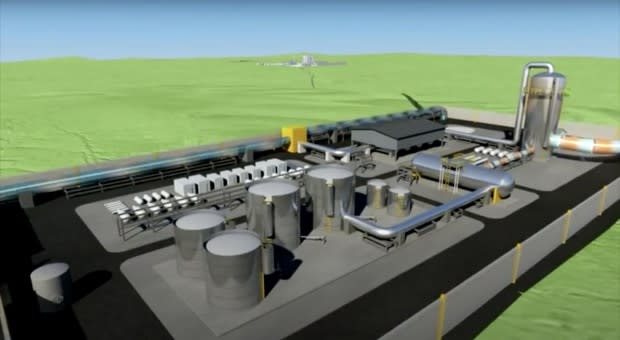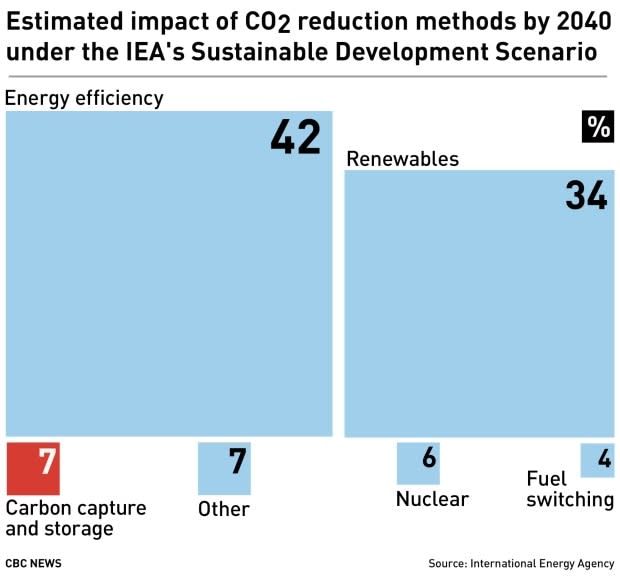At long last, new carbon capture project launches in Alberta
After more than a decade in the works, a new carbon capture project in Alberta is now operational with lofty goals of sequestering large amounts of emissions, while also helping to revitalize the oil industry in the central part of the province.
The Alberta Carbon Trunk Line (ACTL) was awarded provincial and federal funding back in 2009 and startup was expected in 2012, but the project has faced several delays including one caused by the oil price crash in 2014.
The system is described as the world's largest capacity pipeline for CO2 from human activity and its capacity represents about 20 per cent of all current oilsands emissions, according to officials with the project.
The $1.2-billion project will take emissions from the Redwater Fertilizer factory and the Sturgeon refinery near Edmonton to aging oil reservoirs in central and southern Alberta.
The project will change how business is done in Alberta, according to Kevin Jabusch, CEO of Enhance Energy, in a statement as part of the project's announcement on Tuesday.
Enhance Energy is part of a consortium of companies that own and operate the ACTL system. The company is injecting the CO2 from the pipeline into its oilfields near Clive, Alta. Jabusch said the project will help produce low-carbon energy, while also reinvigorating a part of the province's rural economy.
"We went through a few business cycles, we went through a few political cycles, but like all good projects, it's one that had to be done, and it's an amazing feeling to have worked so hard to get something done and feels better as a result," he said in an interview.

Initially, ACTL is expected to capture and sequester up to 1.8 megatonnes (Mt) of CO2 each year, the equivalent of taking 339,000 cars off the road, with the long-term potential of up to 15 Mt of CO2 annually.
The CO2 travels down a 240-kilometre pipeline to an area near Red Deer, where it is injected into the ground to produce more oil and natural gas.
The pipeline has excess capacity, so in the future, more facilities and storage reservoirs can be added to the system.
"This is an industrial-scale solution, which is what we need if we are going to make a dent in carbon [emissions]. I feel very good about the outlook for the growth of this business," said Jeff Pearson, with Wolf Midstream, which operates the pipeline.

The project initially gained publicity when it was promised $63 million from the federal government under then-prime minister Stephen Harper and $495 million from the provincial government under former Conservative premier Ed Stelmach.
Since then, governing parties in the province have varied in their support for carbon capture projects:
In 2011, Alison Redford said Alberta should find "better initiatives and opportunities" to reduce emissions than expensive gambles with CCS.
In 2014, Jim Prentice dismissed it as a "science experiment."
In 2015, Rachel Notley said she would continue funding the projects only because the government was trapped in contracts.
In 2019, environment minister Jason Nixon described CCS as an example of "innovative, game-changing technology."
Critics of carbon capture projects argue the funding would be better spent on renewable energy to tackle climate change, while others say such projects may make people and industry complacent about reducing emissions.

There are three other large carbon capture projects in the country:
Boundary Dam, a coal-fired power plant operated by SaskPower that started capturing carbon in 2014.
Quest, an oilsands project run by Shell Canada that started capturing carbon in 2015.
Weyburn, which captures CO2 from a North Dakota-based coal gasification and power plant, and transports it by pipeline to the Weyburn oilfield in Saskatchewan.
There are some other projects in development, including Carbon Engineering's direct air capture plant in Squamish, B.C., and the Alberta Carbon Conversion Technology Centre in Calgary, where five of the XPrize finalists will be testing their ideas.
In addition, some smaller scale projects also exist such as Canadian Natural Resources' sequestering of CO2 to treat tailings ponds in the oilsands.

The Intergovernmental Panel on Climate Change has said that in order to avoid the worst effects of climate change, the world needs to reach net-zero carbon emissions by 2050— that is, one molecule of CO2 has to be sequestered for every molecule emitted.
Global use of fossil fuels isn't expected to dry up for decades and that's why some experts say carbon capture projects have the potential to ensure the oil and gas industry can be part of a net-zero world.


